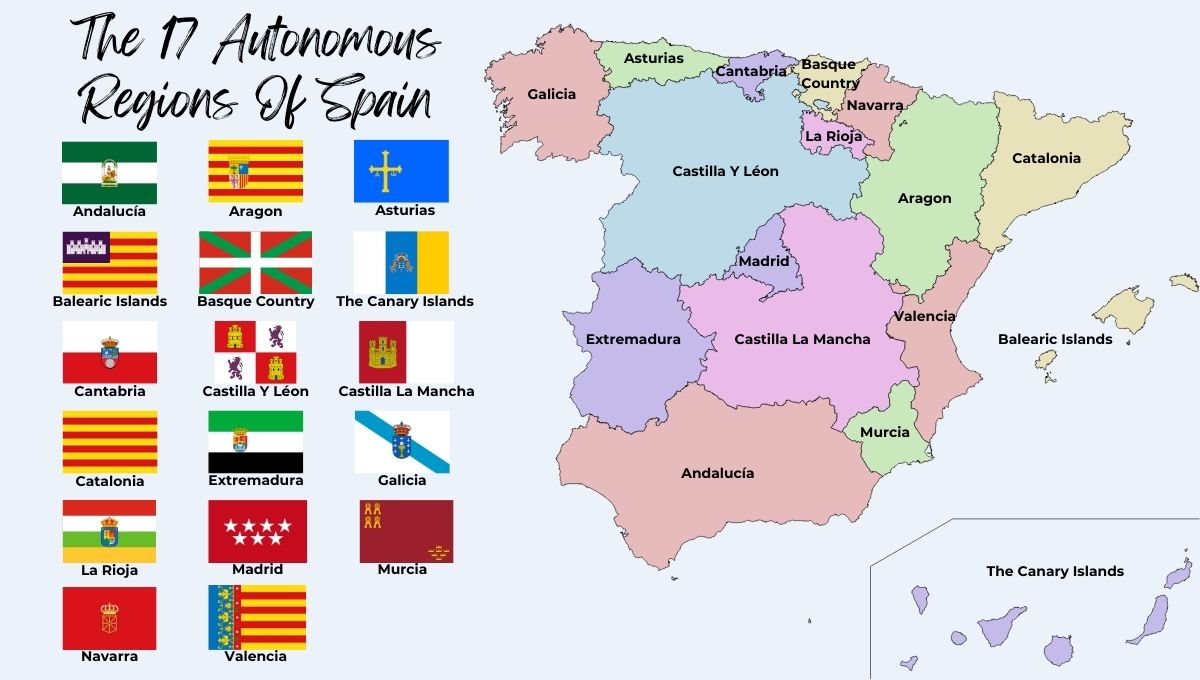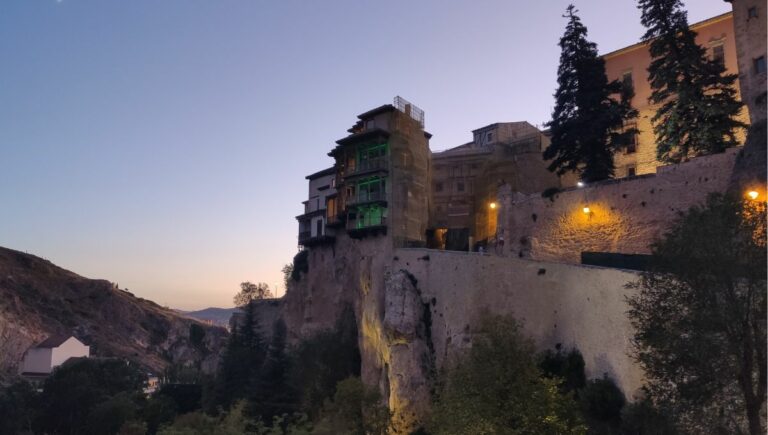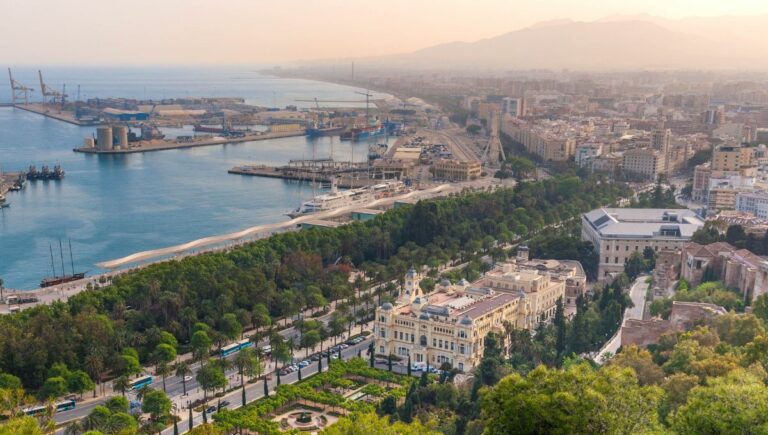Spain, a tapestry of diverse landscapes and cultures, offers a myriad of living and visiting options. The heart of this diversity beats in its 17 autonomous regions, each a unique blend of tradition, governance, and natural beauty, spread across 50 provinces.
These Spanish regions, under the auspices of the 1978 Spanish Constitution and their statutes, enjoy a degree of self-governance, allowing each to cultivate its distinct identity.
So … do you imagine yourself basking in the Mediterranean sun on the beaches of the Balearic Islands, or would you prefer the vibrant city life of the mainland? Maybe the unique allure of the Canary Islands calls to you, with their volcanic landscapes and perennial spring climate.
Whether you’re drawn to the bustling streets of tourist favourites or the tranquil charm of hidden gems, these different regions of Spain offer a spectrum of experiences.
So, let’s take a closer look as we explore the autonomous communities of Spain.
You may also find helpful: Spain tourist visa guide
Andalucía
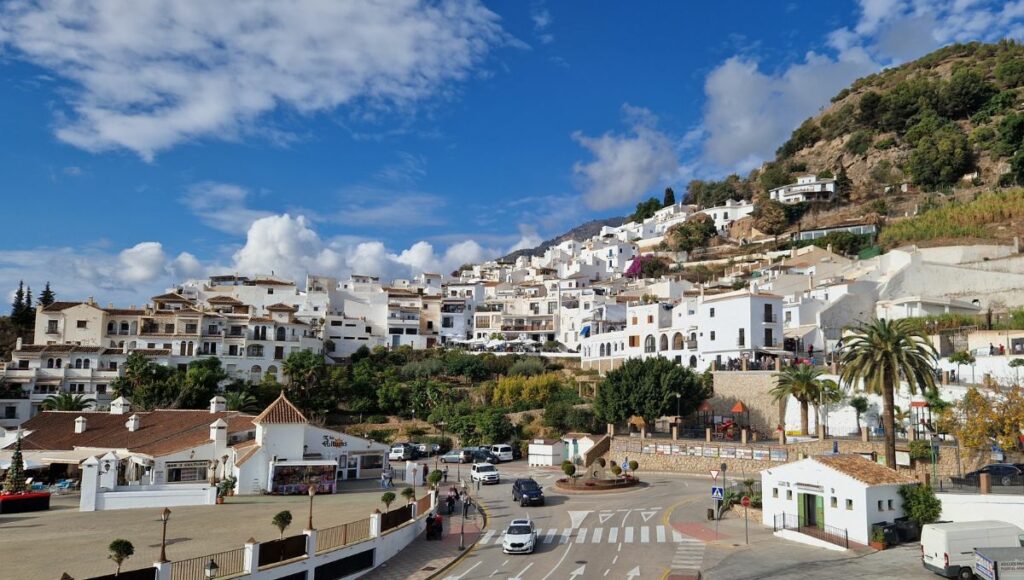
Provinces Include: Almeria, Cádiz, Cordoba, Granada, Huelva, Jaén, Malaga, and Seville.
When tourists think of Spain, they probably imagine Andalucía. It is one of the most popular 17 regions of Spain, covering the entire southern portion of the mainland and home to numerous beaches and whitewashed villages. The most popular autonomous cities are Seville and Marbella.
However, this autonomous region also includes Costa de Almeira, Costa del Sol, Costa de la Luz, and Costa Tropical.
From the rolling hills of the interior to the sparkling beaches that line its coasts to iconic structures such as the Alcázar Palace in Seville, Andalucía offers a diverse array of experiences and is popular as the home of flamenco dancing, world-class golf courses, and countless fiestas.
Cultural Highlights
- Flamenco – This passionate and seductive art form, encompassing singing, guitar playing, dance, and handclaps, originated in Andalucía and is integral to its cultural identity.
- The Alhambra – Located in Granada, this stunning Moorish fortress and palace complex is a UNESCO World Heritage Site and symbolizes the historical confluence of cultures in Andalucía.
- Ferias and Fiestas – Andalucía is famous for its vibrant festivals, including the Feria de Abril in Seville and the Carnival of Cádiz, where the streets come alive with music, dance, and celebration.
Iconic Dishes
- Gazpacho – This cold tomato-based soup, perfect for hot summer days, epitomizes Andalucían cuisine with its refreshing flavours.
- Paella Andaluza – While paella is often associated with Valencia, Andalucía has its own version, featuring local seafood and often enjoyed on the coast.
- Jamón Ibérico —The province of Huelva is famous for producing some of the world’s best Iberian ham, a delicacy savoured worldwide.
Famous People
- Pablo Picasso – Born in Málaga, Picasso is one of the most influential artists of the 20th century, co-founding the Cubist movement.
- Federico García Lorca – Hailing from Granada, Lorca is a celebrated poet and playwright known for his profound impact on Spanish literature.
- Camarón de la Isla – Born in San Fernando, Cádiz, Camarón is a legendary flamenco singer remembered for his revolutionary impact on the genre.
In my experience, spending time in Andalucía, the charm lies not only in its scenic landscapes and historical monuments but also in the warmth of its people and their zest for life. From the solemnity of Holy Week processions to the lively beachside chiringuitos, Andalucía embodies a blend of tradition and modernity, making it an unforgettable destination for those seeking the soul of Spain.
Aragon

Provinces include: Huesca, Teruel, and Zaragoza.
Aragon, a region steeped in history and natural beauty, often flies under the radar for many tourists visiting Spain. These landlocked autonomous areas are less-known and are among the least visited regions of Spain. This north/northeast area is also home to the Aragonese Pyrenees Mountains.
The beautiful part of Spain also borders France and is home to seven ski resorts. It’s the perfect place for those who love a quiet area with mountains, rugged landscapes, ancient towns, and the tranquillity of lesser-trodden paths.
Cultural Highlights
- The Aragonese Pyrenees – This majestic mountain range offers breathtaking landscapes, hiking trails, and winter sports opportunities, including seven ski resorts that appeal to snow enthusiasts.
- Dinópolis – Located near Teruel, this dinosaur theme park is a dream come true for families and dinosaur enthusiasts alike. My recent visit there was a hit with the kids, combining educational experiences with fun and excitement.
- Mudéjar Architecture of Aragón – Recognized by UNESCO, this architectural style reflects the confluence of Christian and Islamic art, with notable examples in Teruel and Zaragoza demonstrating the rich cultural tapestry of the region.
Iconic Dishes
- Ternasco de Aragón – This traditional dish, made from young lamb, is a testament to Aragon’s rich culinary traditions, offering flavours deeply rooted in the region’s agricultural practices.
- Borrajas – A vegetable dish featuring borage leaves, often cooked with potatoes and accompanied by a touch of olive oil, showcasing the simplicity and freshness of Aragonese cuisine.
- Migas – A humble yet hearty dish, migas is made from breadcrumbs fried with garlic, chorizo, and sometimes bacon, embodying the resourcefulness of the region’s cooking.
Famous People
- Francisco de Goya – Born in Fuendetodos, Zaragoza, Goya is one of Spain’s most important painters and printmakers, known for his profound and often haunting works.
- Santiago Ramón y Cajal – Hailing from Petilla de Aragón, Navarre (near the Aragonese border), this Nobel laureate is the father of modern neuroscience, with his groundbreaking work laying the foundations for the field.
- Luis Buñuel – Although more commonly associated with other regions due to his extensive travel, this pioneering filmmaker, born in Calanda, Teruel, left a significant mark on the surrealist movement and cinema worldwide.
Despite its status as one of the least visited regions in Spain, Aragon’s charm lies in its ability to offer peace, beauty, and a deep connection to Spain’s historical roots and natural wonders. From the snow-capped peaks of the Pyrenees to the echoes of history in its ancient towns and monuments, such as the Basilica of Our Lady of the Pillar, Aragon presents a different facet of Spanish heritage, ripe for exploration.
Asturias
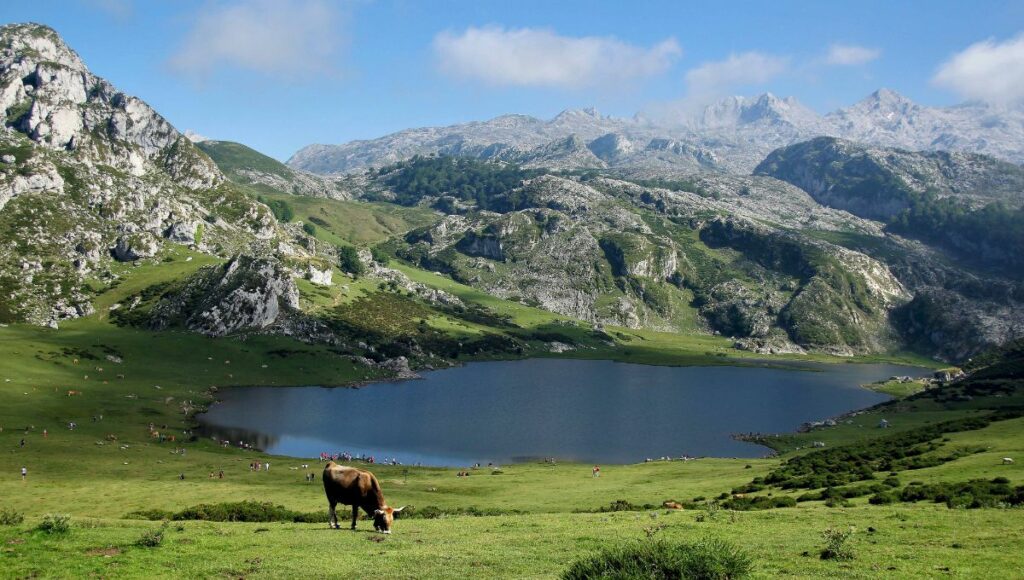
Asturias is a single province region.
The area of Asturias is one of the few of the 17 regions of Spain that are single-province autonomous regions. The lush, rugged landscape is home to Costa Verde, with beautiful sandy beaches. Picos de Europa National Park is loved by outdoor enthusiasts who enjoy hiking, climbing, kayaking, and cavers.
This lush area has higher annual rainfall than other regions. The region’s capital, Oviedo, and Gijón are the two largest cities. Gijón sits on the west side of the Bay of Biscay, and Oviedo is about 12 miles (19 km) south.
Cultural Highlights
- Picos de Europa National Park – A paradise for outdoor enthusiasts, this national park offers stunning landscapes for hiking, climbing, and exploring Spain’s natural beauty.
- Oviedo’s Pre-Romanesque Monuments – These UNESCO World Heritage Sites, including the Church of San Julián de los Prados, offer a glimpse into the region’s rich history and architectural innovation.
- Fiesta de San Mateo – Held in Oviedo, this festival transforms the city into a vibrant hub of concerts, traditional music, and cider tasting, celebrating Asturian culture at its finest.
Iconic Dishes
- Fabada Asturiana – This hearty bean stew, made with fabes (large white beans), chorizo, morcilla (blood sausage), and ham, embodies the soul of Asturian cuisine.
- Cachopo – Similar to a Cordon Bleu, cachopo consists of two large veal fillets filled with ham and cheese, then breaded and fried, offering a decadent taste of local flavours.
- Sidra (Cider) – Asturias is renowned for its traditional cider, made from local apples and poured from a height to aerate it, creating a refreshing and effervescent drink that is integral to Asturian culture.
Famous People
- Fernando Alonso – Born in Oviedo, Alonso is a two-time Formula One World Champion, known for his remarkable skill and determination on the racetrack.
- Leopoldo Alas “Clarín” – A prominent Spanish realist novelist, Clarín was born in Zamora but lived and wrote in Oviedo, where his most famous work, “La Regenta,” is set.
- Benito Jerónimo Feijoo – Hailing from Casdemiro, this 18th-century monk and scholar was a leading figure of the Spanish Enlightenment, contributing significantly to the cultural and intellectual landscape of Asturias and beyond.
Asturias captivates visitors with its blend of natural splendour and cultural richness. From the rolling waves of the Costa Verde to the towering peaks of the Picos de Europa and Pre-Romanesque churches, the region offers endless opportunities for adventure and discovery.
Basque Country
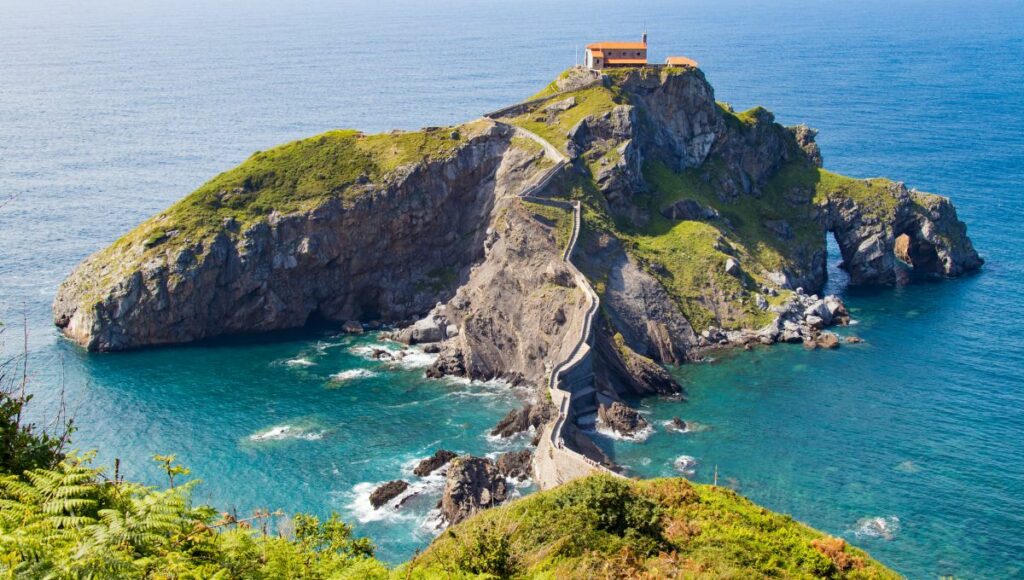
Provinces Include: Álava, Guipúzcua, and Vizcaya.
There is a lot to be discovered in these autonomous areas of Spain. The three provinces that make up Basque Country border France and the Bay of Biscay. Its distinct identity with its own Basque Parliament, language (Euskara), and flag marks its attitude of independence and unique cultural heritage.
The Basque Country captivates visitors with its stunning landscapes, from the serene beauty of the Rioja Alavesa wine region to the dramatic cliffs along the coast. San Sebastián, with its renowned culinary scene, offers a feast for the senses, boasting more Michelin stars per capita than almost anywhere else in the world. Bilbao, once an industrial heartland, has transformed into a hub of artistic expression and innovation, symbolized by the Guggenheim’s shimmering titanium curves.
Cultural Highlights
- Guggenheim Museum – Located in Bilbao, this modern and contemporary art museum, designed by Frank Gehry, has become an icon of 21st-century architecture and a major attraction in the region.
- San Sebastián International Film Festival – An annual event that draws cinema enthusiasts and filmmakers from around the world, highlighting the city’s vibrant cultural scene.
- Basque Festivals – The Basque Country is famous for its festivals, such as the vibrant San Fermín in Pamplona and the Basque Country’s own unique celebrations that showcase its rich cultural traditions, music, and dance.
Iconic Dishes
- Pintxos – Similar to tapas but with their own Basque flair, pintxos are small snacks, often skewered with a toothpick, showcasing a variety of local ingredients.
- Bacalao al Pil Pil – A staple of Basque cuisine, this dish features salt cod in a garlic and olive oil sauce and is known for its unique emulsification technique.
- Txuleta – A thick-cut steak, usually from older cows, grilled over coals, and served in cider houses or steakhouses across the region, celebrating the Basque love for meat.
Famous People
- Eduardo Chillida – A renowned sculptor from San Sebastián, Chillida’s works, which often play with space and form, have earned global recognition.
- Cristóbal Balenciaga – Hailing from Getaria, Balenciaga was a revolutionary fashion designer whose innovative designs have left a lasting mark on the fashion world.
- Juan Sebastián Elcano – Born in Getaria, Elcano was the first person to circumnavigate the globe, completing Magellan’s voyage and marking a monumental moment in history.
Exploring the Basque Country reveals a community deeply proud of its heritage and language yet forward-thinking and welcoming to visitors. Each province, from Álava’s vineyards to Guipúzcoa’s coastal towns and Vizcaya’s bustling cities, tells a part of the Basque story. In my journeys, I’ve found that the essence of the Basque Country lies not just in its places but in the spirit of its people—a blend of tradition, resilience, and openness to the world.
Cantabria
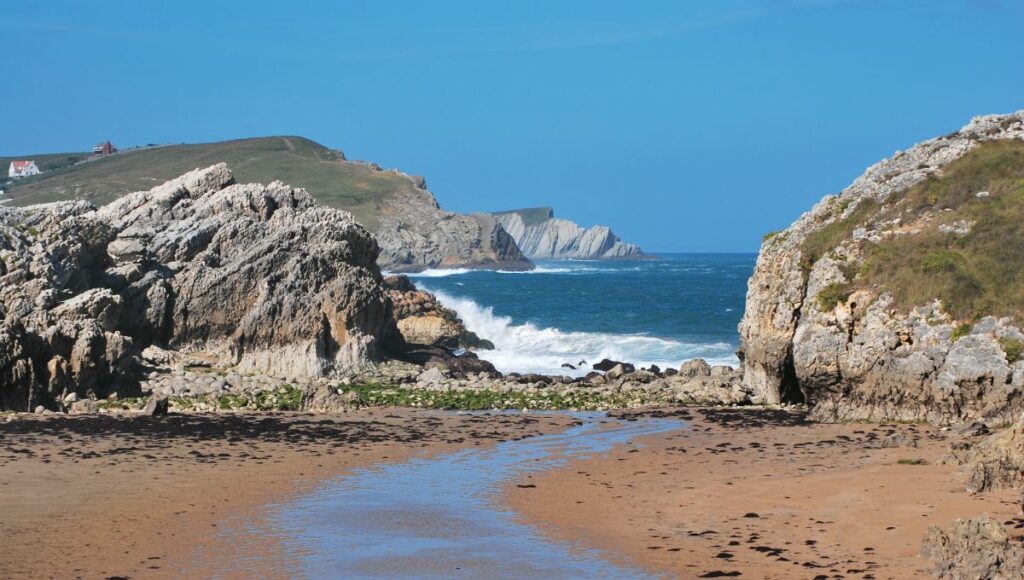
Cantabria is a single province region.
Located on Spain’s north coast, Cantabria has been inhabited for over 15,000 years. Discover the history and cave paintings at Altamira. The port of Santander and the capital city have daily ferries to and from the UK. Thus, making it a high entry point for UK citizens and those wishing to travel to the UK.
The city of Santander rests on the Bay of Biscay and of all 17 regions in Spain it is home to the summer residence of the Spanish Royal family. Here you can spend some time among the several beaches of Costa Cantabria and Costa Verde, I highly recommend Sardinero Beach.
Cultural Highlights
- Cave of Altamira – Known as the “Sistine Chapel of Quaternary Art,” the Altamira Cave houses some of the world’s most important Paleolithic cave paintings, dating back around 15,600 years.
- Palacio de la Magdalena – Situated on the Magdalena Peninsula in Santander, this palace serves as the summer residence of the Spanish Royal Family, offering a glimpse into royal leisure and the region’s architectural beauty.
- Festival Internacional de Santander – An annual celebration of music and arts, this festival attracts performers and audiences from around the globe, highlighting Cantabria’s vibrant cultural scene.
Iconic Dishes
- Cocido Montañés – A hearty stew made from beans, cabbage, and pork, this dish reflects Cantabria’s rural culinary traditions and is perfect for the region’s cooler climate.
- Sobao Pasiego – A sweet, buttery cake originating from the Pas valley, Sobao Pasiego is a delightful treat enjoyed across Cantabria.
- Anchovies from Santoña – The fishing town of Santoña is renowned for its anchovies, prepared in a traditional method that has been perfected over generations.
Famous People
- Marcelino Menéndez Pelayo – Born in Santander, Menéndez Pelayo was a prominent scholar and historian known for his works on Spanish literature and intellectual history.
- Severiano Ballesteros – Hailing from Pedreña, Ballesteros was one of golf’s most charismatic and talented figures, winning five major championships.
- Beato de Liébana – A medieval monk, Beato was a significant religious figure and scholar whose works had a considerable influence on the region’s spiritual life.
The connection between land and sea defines much of Cantabrian life, from culinary traditions to seafaring heritage and ancient Altamira Caves.
Castilla La Mancha
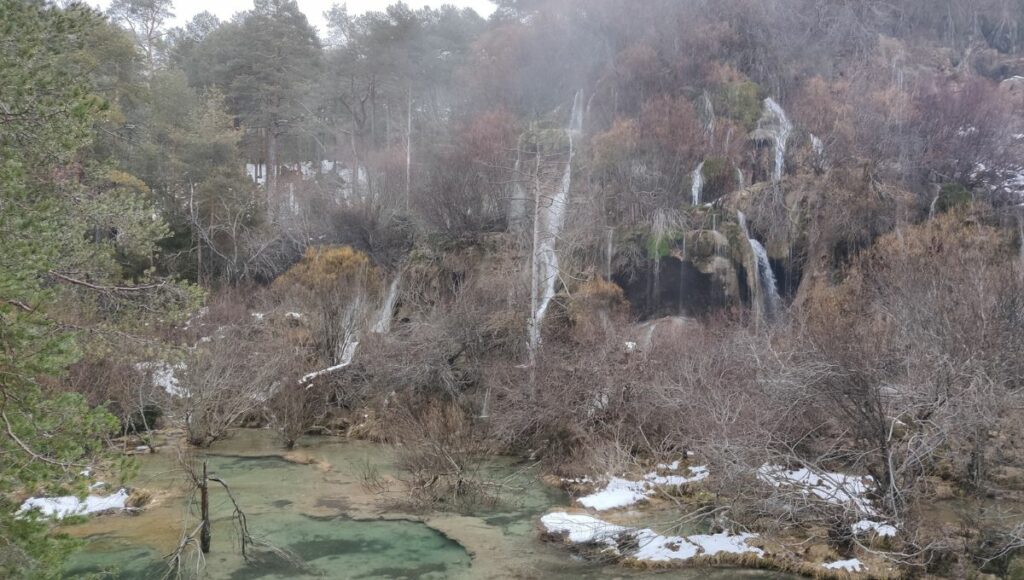
Provinces include: Albacete, Ciudad Real, Cuenca, Guadalajara, and Toledo.
If you like vineyards and castles, then this is one of the 17 regions in Spain you will like. The landlocked region of Castilla La Mancha is the second largest region in Spain and is situated next to the capital of Madrid.
The former capital city, Toledo, is home to the 13th-century High Gothic Cathedral and many El Greco paintings. This mountainous region is becoming very popular due to its Renaissance buildings, museums, and churches.
Cultural Highlights
- Windmills of Consuegra – Near Toledo, these iconic windmills are famously featured in “Don Quixote” as the “giants” that the titular character jousts with, symbolizing the region’s literary heritage.
- Toledo’s High Gothic Cathedral – A masterpiece of medieval architecture, the cathedral stands as a monumental beacon of religious art and history in the former capital.
- The Hanging Houses of Cuenca – Perched precariously on the cliffs above the Huécar river gorge, these houses create a stunning visual that captures the imagination of all who visit.
Iconic Dishes
- Manchego Cheese – This world-famous cheese, made from the milk of the Manchega breed of sheep, embodies the essence of Castilla-La Mancha’s culinary tradition.
- Migas – A humble yet delicious dish, traditionally made from leftover bread, garlic, and chorizo, migas is a testament to the region’s rustic, comforting cuisine.
- Pisto Manchego – Often referred to as Spanish ratatouille, this vegetable stew, rich in tomatoes, peppers, zucchini, and onion, showcases the bounty of Castilla-La Mancha’s gardens.
Famous People
- Miguel de Cervantes – Often hailed as the greatest writer in the Spanish language, Cervantes, best known for “Don Quixote,” was born in Alcalá de Henares, near the border of Castilla-La Mancha.
- El Greco – Although originally from Crete, this painter spent much of his life in Toledo, where his unique style flourished, deeply influencing the Spanish Renaissance.
- Sara Montiel – Born in Campo de Criptana, Ciudad Real, Montiel was a renowned actress and singer, celebrated for her contributions to Spanish cinema and music.
As you’d expect from such a large region, it requires a lot of exploring, which is a challenge I enjoy. I’m an avid fan of the town of Cuenca, with its iconic hanging houses. I love the Serranía de Cuenca Natural Park, and one of my favourite red wines is also from this region, Paso de Buey.
Castilla Y Léon
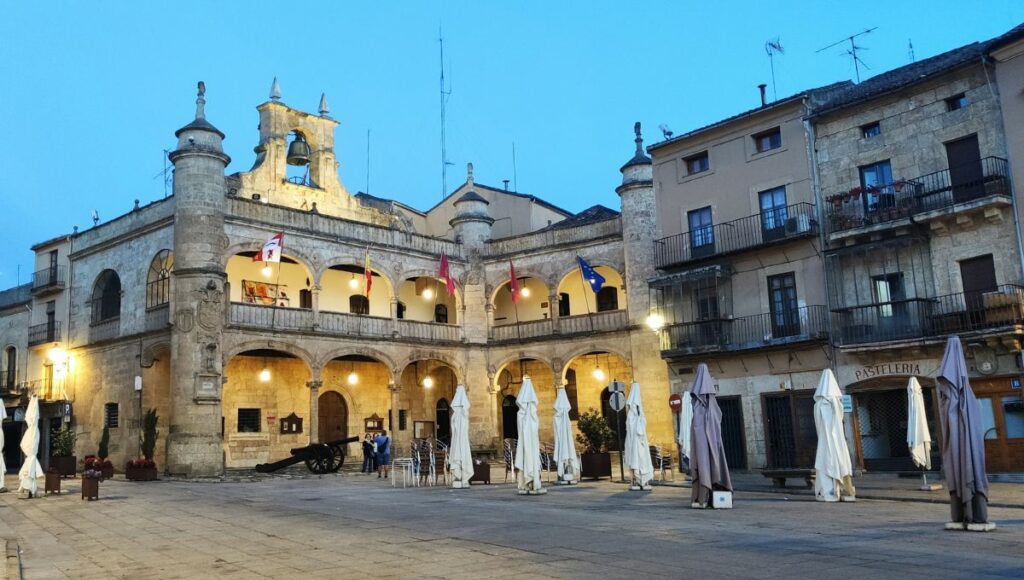
Provinces include: Avila, Burgos, Léon, Palencia, Salamanca, Segovia, Soria, Valladolid, and Zamora.
This landlocked area of Spain is the largest of all the autonomous regions. Surrounded by mountains and bordering Portugal, it is a little more challenging to get to. Thus, it makes it a little more off the beaten track with fewer tourists than in other areas of Spain, but holds a special place in my heart.
Cultural Highlights
- Salamanca University – Founded in the 12th century, it’s one of the world’s oldest universities, radiating intellectual and architectural grandeur.
- Walls of Ávila – These imposing medieval walls offer a glimpse into Spain’s rich history, encircling the old town of Ávila with a perimeter of about 2.5 km.
- The Segovia Aqueduct – A marvel of ancient engineering, this Roman aqueduct towers over the city of Segovia, its imposing arches symbolizing the enduring legacy of Roman infrastructure. Built around the 1st century AD, it stands as one of the best-preserved monuments of its kind in the world.
Iconic Dishes
- Cochinillo asado (Roast Suckling Pig) – A culinary specialty of Segovia, this dish is celebrated for its crispy skin and tender meat, traditionally cooked in wood-fired ovens.
- Lechazo (Roast Lamb) – Particularly revered in Burgos and Valladolid, this dish embodies the region’s rich pastoral traditions.
- Hornazo – Common in Salamanca, this savoury pastry filled with pork, chorizo, and hard-boiled eggs, serves as a delightful picnic staple, especially during the “Lunes de Aguas” festival.
Famous People
- Miguel Delibes – Born in Valladolid, Delibes is one of Spain’s most respected novelists, portraying rural life and landscapes with profound empathy.
- Santa Teresa de Jesús (Teresa of Ávila) – A mystic, writer, and reformer from Ávila, her work and life have left a lasting impact on Spanish literature and Catholic spirituality.
- Antonio de Nebrija – His work in Salamanca, especially the creation of the first grammar book for the Spanish language, marks him as a pivotal figure in the history of the Spanish language.
This area offers authentic Spanish culture and a lot of history dating back to the Celtic era with no shortage of places to visit. The regional capital city, Salamanca, is famous for its ornate sandstone architecture, and Salamanca University was founded in the 1100s. Segovia has a history dating back to the Roman times with its iconic aqueduct.
Then there is the place close to my heart, the Sierra Francia mountains and la Pena de Francia, a sleepy area close to the Portuguese border where I spend most of my summers with my in-laws.
Catalonia
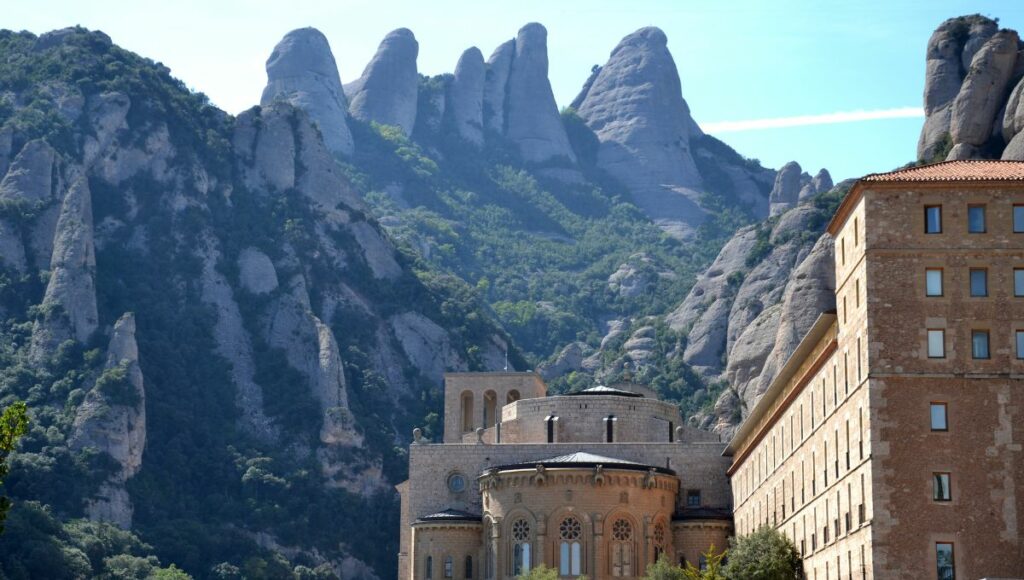
Provinces include: Barcelona, Girona, Lleida, and Tarragona.
This area of Spain is best known for its capital city, Barcelona. It is a tourist hot spot year-round and a melting pot of international ex-pats. It is probably the most popular of the 17 autonomous communities in Spain.
This cosmopolitan city is known for its museums, Roman archaeological sites, art, and Modernist architecture. The cobblestone maze of the city centre will bring you to countless shops, restaurants, and bars.
A personal highlight is the mountains of Montjuic and Tipadado; they will give you unobstructed views of the city and sea, including the iconic Sagrada Familia, from afar. Works from Antoni Gaudí, Picasso, Fundació Joan Miró, among others, are scattered throughout the city.
Cultural Highlights
- La Mercè Festival – Barcelona’s grand street party in honour of its patron saint, featuring concerts, dances, and human towers, showcases the city’s vibrant cultural life.
- Dalí Theatre-Museum – Located in Figueres, Girona, this museum designed by Salvador Dalí himself is as surreal as the works it houses, offering a deep dive into the artist’s imaginative world.
- Penedès Wine Region – Nestled between the coastal and pre-coastal mountains, this region is famous for producing Cava, Spain’s answer to champagne, and a wide range of high-quality wines.
Iconic Dishes
- Pa amb Tomàquet – Simplicity at its finest, this dish of bread rubbed with tomato and drizzled with olive oil and salt, sometimes topped with ham or cheese, is a Catalan staple.
- Catalan Creme – Known locally as Crema Catalana, this dessert is similar to crème brûlée but infused with a hint of lemon zest and cinnamon.
- Escudella i Carn d’Olla – A hearty stew that is particularly popular during the winter months, featuring a variety of meats, vegetables, and sometimes rice or pasta.
Famous People
- Antoni Gaudí – An architect whose works, like the Sagrada Família and Park Güell in Barcelona, are synonymous with Catalan modernism, Gaudí’s distinctive style has left an indelible mark on the world.
- Joan Miró – Born in Barcelona, Miró was a painter, sculptor, and ceramicist known for his abstract art and surrealistic creations that have influenced the global art scene.
- Pau Casals – Renowned cellist and conductor from El Vendrell, Tarragona, Casals is celebrated for his musical genius and profound humanism.
Countless beaches and beach communities, including Costa Brava and Costa Dorada, offer open space and hidden craggy coves to enjoy the sunshine. Spanish and Catalan are spoken throughout this region.
Catalonia’s allure is not just in its scenic beauty or historic legacy but in the spirit of its people, who maintain a fierce sense of identity and pride in their cultural heritage. The region’s dual language, dynamic festivals, and commitment to innovation make it a fascinating place to explore, reflecting a community that honours its past while eagerly embracing the future.
Extremadura
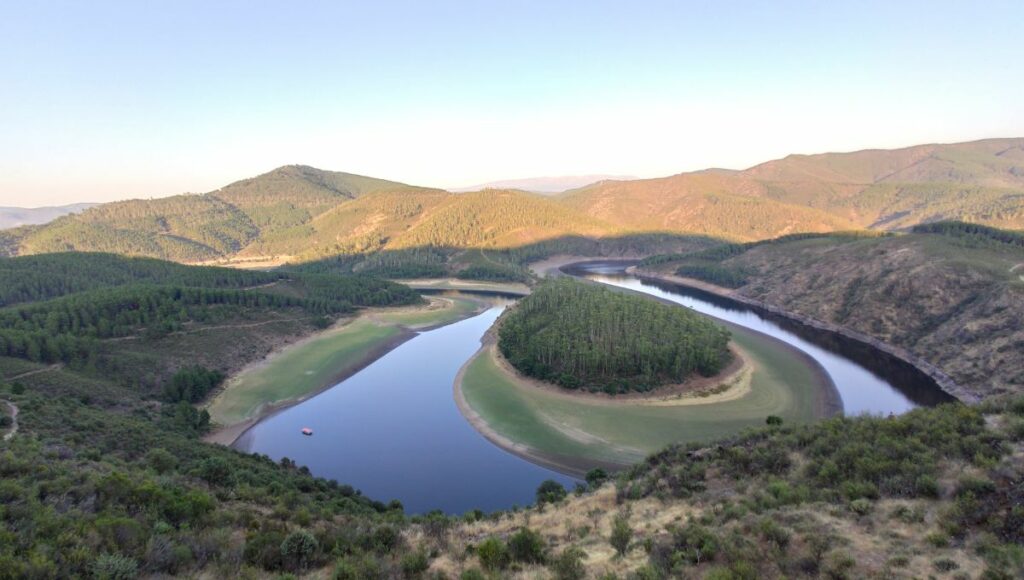
Provinces include: Caceres and Badajoz.
Of the 17 autonomous communities in Spain, this landlocked region is almost untouched by tourists. Nestled in southwest Spain, Portugal surrounds it to the west, Andalucía to the south, and Leon and Castile to the east and north.
A couple of highlights for me are the town of Mérida, which is a must-visit if you have an interest in Roman history. In addition, the natural parks of the north, close to the border with Castilla Y Leon, are a treasure trove of natural hiking paths and wildlife.
Cultural Highlights
- Cáceres Old Town – A UNESCO World Heritage Site, the Old Town of Cáceres is a stunning example of medieval architecture, its cobbled streets and ancient walls whispering tales of yesteryears.
- Monfragüe National Park – For nature enthusiasts, Monfragüe offers breathtaking landscapes, home to diverse flora and fauna, including the Spanish imperial eagle.
- Roman Theatre of Mérida – In Badajoz, Mérida’s ancient Roman Theatre stands as a testament to the region’s historical significance, where the past comes alive through its well-preserved ruins.
Iconic Dishes
- Torta del Casar – This creamy, intense sheep’s milk cheese from Cáceres is a culinary treasure, celebrated for its unique taste and texture.
- Jamón Ibérico de Bellota – Extremadura is renowned for its acorn-fed Iberian ham, a delicacy that epitomizes the region’s gastronomic excellence.
Famous People
- Hernán Cortés – Born in Medellín, Badajoz, Cortés was a conquistador who led an expedition that caused the fall of the Aztec Empire, marking a significant chapter in Spanish colonial history.
- Francisco Pizarro – Hailing from Trujillo, Cáceres, Pizarro was another conquistador known for his conquest of the Incan Empire, emphasizing Extremadura’s impactful role in world history.
With lakes, forests, and mountains, this area is ideal for those who don’t want to live by the water. The historic towns, ancient city walls, and National Parks are perfect for history buffs and nature lovers.
Galicia

Provinces include: A Coruña, Lugo, Orense, and Pontevedra.
Galicia rests above Portugal on Spain’s northwest coast. With mountain ranges, lush landscapes, fjord-like areas, and sandy beaches are different than any other region of Spain. It is the most popular of Spain’s autonomous regions for those following the Camino de Santiago pilgrimage route.
Cultural Highlights
- Camino de Santiago – Galicia is famed as the culmination of this ancient pilgrimage route, with Santiago de Compostela’s cathedral as the ultimate goal for thousands of pilgrims yearly.
- Tower of Hercules – Standing guard over the coast of A Coruña, this ancient Roman lighthouse is a UNESCO World Heritage Site and symbolizes Galicia’s maritime heritage.
- Albariño Wine – Hailing from the Rías Baixas region, Albariño is my absolute favourite white wine in the world. Its crisp, aromatic qualities perfectly capture the essence of Galicia’s coastal terroir.
Iconic Dishes
- Pulpo a la Gallega – This simple yet delicious dish of boiled octopus served with paprika, rock salt, and olive oil is a testament to Galicia’s rich seafood tradition.
- Empanada Gallega – A versatile and beloved pastry, this empanada can be filled with anything from tuna to chorizo, but always encapsulates the hearty, rustic flavours of Galicia.
- Tarta de Santiago – A delightful almond cake dusted with powdered sugar, often featuring the Cross of Saint James, it’s a sweet treat deeply rooted in Galician tradition.
Famous People
- Rosalía de Castro – Born in Santiago de Compostela, Castro is a revered figure in Galician literature, known for her poetry that beautifully captures the Galician spirit and its landscapes.
- Francisco Franco – This controversial figure in Spanish history hailed from Ferrol, A Coruña, and his legacy is a complex part of Spain’s 20th-century narrative.
- Martin Codax – A legendary figure from the Middle Ages, Codax was a Galician troubadour whose music and poetry celebrate the region’s cultural and linguistic identity.
Discover a variety of shellfish in the fishing port of Cambados. Visit the Tower of Hercules lighthouse. Be sure to sample Galicia’s tantalizing white wine, Albariño.
La Rioja
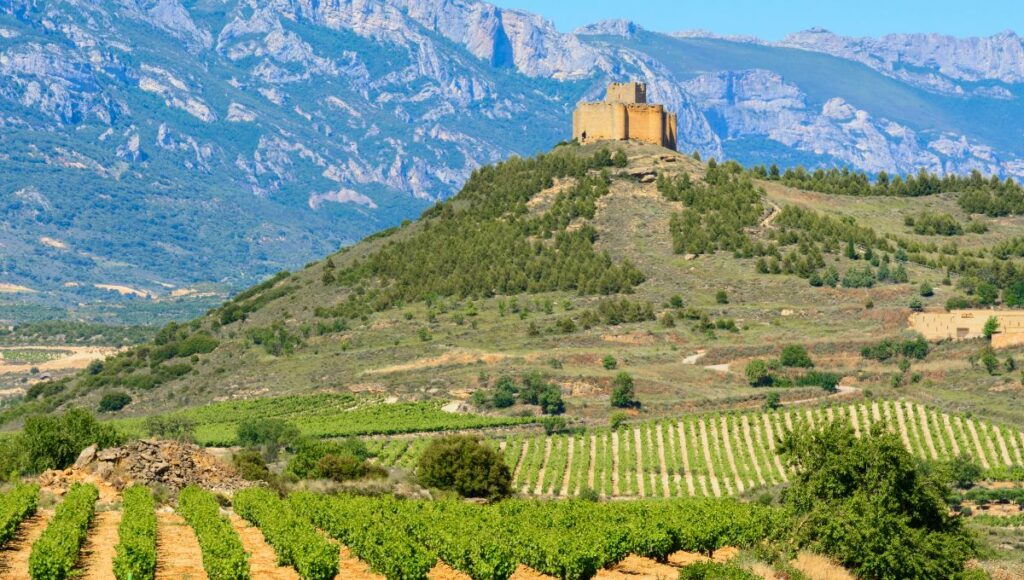
La Rioja is a single province region.
La Rioja, a name synonymous with exceptional wines, embodies the heart and soul of Spain’s vinicultural excellence. As the smallest of Spain’s autonomous regions, it holds a grand stature in the world of wine, offering an immersive experience into the traditions and innovations of winemaking.
Nestled in northern Spain, this single-province region is a paradise for oenophiles. Over 500 wineries, from age-old bodegas to avant-garde establishments, dot its landscapes.
Cultural Highlights
- Rioja Wine – La Rioja is celebrated for its dynamic wine culture, with tours and tastings providing insights into winemaking’s meticulous art. The region’s wines, particularly its barrel-aged reds, are lauded for their depth, complexity, and variety.
- The Way of St. James – La Rioja is traversed by the famous Camino de Santiago, with pilgrims passing through picturesque towns like Logroño, Santo Domingo de la Calzada, and Nájera, adding a spiritual dimension to its cultural landscape.
- Festivals – The region comes alive with summer fiestas, including the renowned Batalla del Vino (Wine Battle) in Haro, where participants douse each other with wine, celebrating the joy and abundance of La Rioja’s most cherished produce.
Iconic Dishes
- Patatas a la Riojana – This hearty potato and chorizo stew captures the essence of La Rioja’s cuisine, offering warmth and comfort with every spoonful.
- Chuletillas al Sarmiento – Lamb chops grilled over vine shoots is a dish that pays homage to the region’s winemaking tradition, showcasing the deep connection between its agriculture and culinary practices.
Famous People
- Gustavo Bueno – A philosopher born in Santo Domingo de la Calzada, Bueno made significant contributions to Spanish thought and is known for his work on materialist philosophy.
- Pedro Duque – Although not born in La Rioja, Spain’s astronaut of renown has close ties with the region, embodying the spirit of ambition and exploration that resonates with the adventurous nature of La Rioja’s winemakers.
La Rioja’s allure extends beyond its wine. Its landscapes, from the verdant valleys of the Ebro River to the rugged peaks of the Sierra de la Demanda, offer breathtaking backdrops for rural tourism and outdoor adventures.
In my journeys, I’ve found that La Rioja doesn’t disappoint and should be a must-visit for any one that likes a drop of grape juice.
Madrid
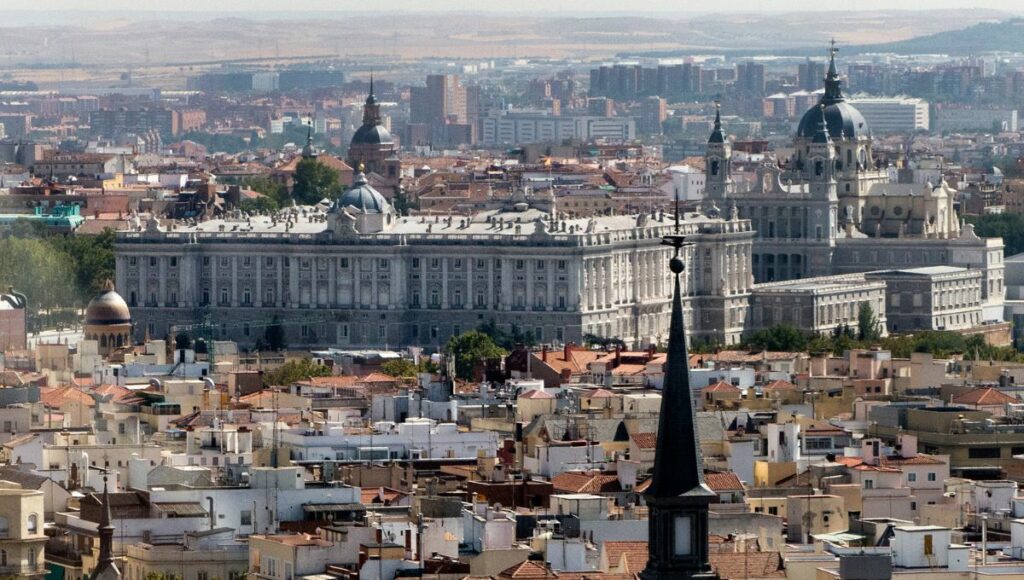
Madrid is a single province region.
The city of Madrid is known as Spain’s capital, but not many people realise it is much more than that. This region is unique in that it is both a city and a community within a single province, with some wonderful small towns and villages you can explore outside the city centre.
El Escorial, Alcala de Henares, and Aranjuez are the three most popular places to visit. These are the king’s historical residence, a UNESCO World Heritage Site, and the King’s spring home.
Back in the city, you’ll find endless activities such as the iconic art galleries, The Prado and Reina Sofia, the buzz of the city life in Gran Via and Puerta del Sol, a chance of a ride on a row boat in El Retiro Park and some of the best restaurants in the world.
Cultural Highlights
- The Prado Museum – Home to one of the finest collections of European art, the Prado boasts masterpieces by Velázquez, Goya, and El Greco, standing as a beacon of Madrid’s cultural heritage.
- El Escorial – Nestled in the foothills of the Sierra de Guadarrama, this historical residence of the Spanish monarchy is a monumental complex of palatial, monastic, and scholarly functions. Its blend of architectural grandeur and historical significance makes it a fascinating destination.
- Royal Palace of Madrid – Although no longer the royal family’s residence, this opulent palace remains a symbol of Spanish majesty and is accessible for public tours.
Iconic Dishes
- Cocido Madrileño – This hearty chickpea-based stew, simmered with meats and vegetables, embodies the soul-warming comfort food of Madrid.
- Callos a la Madrileña – A traditional tripe dish that is both loved and debated by locals and visitors, featuring a spicy and flavorful sauce.
- Churros con Chocolate – Whether after a night out or for a leisurely breakfast, dipping crispy churros into thick, hot chocolate is a quintessential Madrid experience.
Famous People
- Penélope Cruz – Born in Alcobendas, Madrid, Cruz is an internationally acclaimed actress and the first Spanish actress to receive an Academy Award.
- Plácido Domingo – Hailing from Madrid, Domingo is a world-renowned opera singer, conductor, and arts administrator, known for his powerful voice and versatility.
- Francisco Goya – Though not born in Madrid, Goya spent much of his life in the city, becoming one of Spain’s most important and influential painters and printmakers.
As you would expect, as Spain’s political and economic centre, the city pulsates with vibrant life and culture. I love the city’s inclusive atmosphere, world-class education systems, and the warmth of its people make it a great place to raise my family. Every day in Madrid invites exploration, from its renowned museums and theaters to its lively plazas and markets.
Murcia

Murcia is a single province region.
Murcia is an autonomous community and a province in the southeast of Spain. The capital and most populous city is Murcia. Andalusia borders the region to the west, Valencia to the north, and the Mediterranean Sea to the east.
The region has a Mediterranean climate, with mild winters and hot summers. Murcia is known for its rich history and culture, which can be seen in its many historic buildings and landmarks. These include the Cathedral of Murcia, which dates back to the 18th century, and the Salzillo Museum, which is dedicated to the works of Francisco Salzillo, one of the most important sculptors of the 19th century.
Cultural Highlights
- Cathedral of Murcia – A masterpiece of Spanish Baroque architecture, the cathedral dominates the cityscape with its grandeur and intricate details.
- Fiestas de Primavera – Celebrated in May, this festival fills the streets of Murcia with flowers, music, and parades, epitomizing the region’s vibrant culture.
- The Roman Theatre of Cartagena – A testament to the region’s ancient history, this theatre is a remarkable archaeological site that transports visitors back to Roman times.
Iconic Dishes
- Paparajotes – A traditional dessert made from lemon leaves coated in batter and deep-fried, then sprinkled with sugar and cinnamon, reflecting Murcia’s agricultural bounty.
- Arroz con conejo – Rice with rabbit is a staple in Murcian cuisine, highlighting the region’s agricultural roots and love for hearty, rustic dishes.
- Caldero – A fish stew that originated from the fishermen of the Mar Menor, symbolizing the blend of Murcia’s coastal resources with its culinary traditions.
Famous People
- Francisco Salzillo – An 18th-century sculptor whose works continue to dazzle in the Salzillo Museum, showcasing the depth of Murcian artistry.
- Isaac Peral – The inventor of the Peral Submarine, born in Cartagena, a city within Murcia. His innovation marks a significant point in naval history.
The region is also home to a number of festivals and events throughout the year, including the Fiestas de Primavera, which takes place in Murcia in May and is considered one of the most important festivals in Spain. The economy of Murcia is largely based on agriculture and tourism.
The region is a major producer of fruits and vegetables, particularly citrus fruits, and is also known for its wine production. In recent years, the region has also seen an increase in tourism, with many visitors coming to enjoy the region’s beaches, historic towns, and natural parks. Murcia is also home to a number of universities, including the University of Murcia, which is one of the oldest universities in Spain.
Navarra

Navarra is a single province region.
Located in the northern region of Spain, Navarra is almost unknown to tourists with the exception of one iconic celebration – the running of the bulls. However, there is much more to it than that and is a great place. The La Rioja wine region and Basque Country are next to it. Additionally, France is to the north, making trips there very convenient. The hills and mountains throughout the area attract nature lovers, especially walkers, climbers, and cyclists.
Cultural Highlights
- San Fermín Festival – Held annually in July in Pamplona, this festival, featuring the Running of the Bulls, draws visitors from around the globe, eager to partake in its adrenaline-fueled excitement and festive atmosphere.
- Royal Palace of Olite – A Gothic castle that was once the residence of the Kings of Navarre, the palace is now a monument to the region’s rich history and architectural beauty.
- The Way of St. James (Camino de Santiago) – Navarra is a key passage for pilgrims on their journey to Santiago de Compostela, offering breathtaking landscapes and spiritual solace.
Iconic Dishes
- Pimientos del Piquillo – These small, sweet red peppers, often filled with meat or seafood, are a hallmark of Navarran cuisine.
- Trucha a la Navarra – Navarra’s rivers are teeming with trout, making this dish of trout wrapped in cured ham a regional specialty.
- Chistorra – A fast-cured sausage from Navarra, chistorra is often served alongside eggs or within local stews, embodying the hearty flavours of the region.
Famous People
- Ernest Hemingway – Although not a native, Hemingway’s frequent visits to Pamplona and his love for the San Fermín festival have left an indelible mark on Navarra’s cultural landscape. His novel “The Sun Also Rises” is credited with bringing international fame to the Running of the Bulls.
- Charles III of Navarre – Known as Charles the Noble, he was a king who significantly contributed to the architectural and cultural development of Navarra during the 15th century.
Navarra is known for its rich history and culture, which can be seen in its many historic buildings and landmarks such as the Royal Palace of Olite, the Gothic Church of San Nicolas and the Castle of Javier. Additionally, the region is famous for the aforementioned Running of the Bulls festival, or San Fermin, which is held every year in Pamplona in July and attracts thousands of tourists.
The Balearic Islands
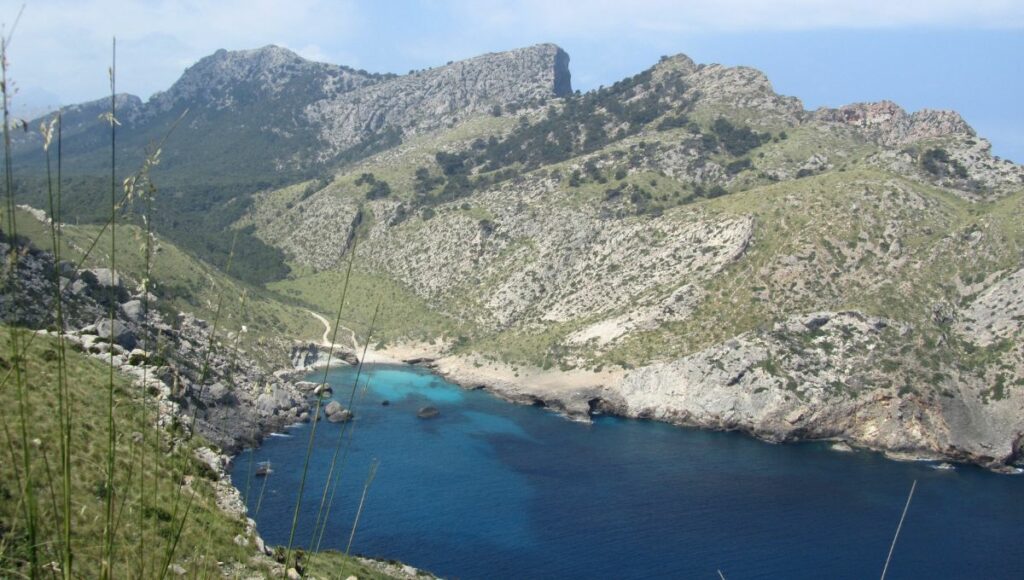
The Balearic Islands are a single province region.
The Balearic Islands are an autonomous community and an archipelago located in the western Mediterranean Sea, near the eastern coast of the Iberian Peninsula. The archipelago is made up of four main islands: Mallorca, Menorca, Ibiza, and Formentera.
The capital of the community is Palma, located on the island of Mallorca. The Balearic Islands are known for their beautiful beaches and clear waters, making them a popular tourist destination. The islands are home to many resorts, hotels, and restaurants catering to tourists, and offer a wide range of activities such as water sports, hiking, and cycling.
Cultural Highlights
- Cathedral of Santa Maria – Often referred to as La Seu, this gothic cathedral in Palma is a monument to the island’s historical layers and architectural grandeur.
- Talayotic Settlements on Menorca – These prehistoric megalithic sites offer a glimpse into the early civilizations that once thrived on the islands, underscoring the deep historical roots of the Balearic Islands.
- Ibiza’s Nightlife – Ibiza is world-renowned for its vibrant club scene, attracting DJs and party-goers from across the globe, yet it also offers serene beauty in its quiet villages and secluded beaches.
Iconic Dishes
- Ensaïmada – This sweet, spiral-shaped pastry from Mallorca is a delightful treat, enjoyed as a breakfast item or an afternoon snack, embodying the simplicity and sweetness of island life.
- Sobrasada – A Balearic specialty, this soft, spreadable sausage made from pork and paprika is a testament to the islands’ rich culinary traditions.
- Pa amb oli – A simple yet beloved dish throughout the islands, consisting of bread rubbed with garlic, tomato, and topped with olive oil and salt, often accompanied by local cheese or ham.
Famous People
- Joan Miró – Though born in Barcelona, the renowned surrealist artist Joan Miró had a profound connection with Mallorca, where he lived and worked for many years.
- Rafael Nadal – The world-famous tennis player hails from Manacor, Mallorca. Nadal’s international success has brought a spotlight to the islands, showcasing their spirit and dedication.
- Jordi Savall – Born in Igualada, Catalonia, Savall has deep connections with the Balearic Islands. He is a globally recognized musician and conductor, celebrated for his contributions to early music.
The islands also have a rich history and culture, with many historic landmarks such as the Cathedral of Santa Maria in Palma and the Talayotic settlements on Menorca.
The Canary Islands

The Canary Islands provinces include: Las Palmas and Santa Cruz de Tenerife.
The Canary Islands are very popular autonomous regions of Spain, They are an archipelago located off the northwest coast of Africa, in the Atlantic Ocean. The archipelago is made up of seven main islands: Tenerife, Fuerteventura, Gran Canaria, Lanzarote, La Palma, La Gomera, and El Hierro. The capital of this community is Santa Cruz de Tenerife (iconic for its famous carnaval), located on the island of Tenerife.
Cultural Highlights
- Carnival of Santa Cruz de Tenerife – One of the world’s largest and most vibrant carnivals, this event transforms Tenerife into a spectacle of colour, music, and revelry.
- Teide National Park – Home to Spain’s highest peak, Mount Teide, this national park on Tenerife is a UNESCO World Heritage Site and a paradise for hikers and stargazers.
- Garajonay National Park – Located on La Gomera, this park is famed for its ancient laurel forests, misty landscapes, and deep cultural significance, also recognized by UNESCO.
Iconic Dishes
- Papas Arrugadas – These “wrinkled potatoes” served with mojo sauce, a spicy garlic mixture, are a beloved Canarian specialty.
- Gofio – A versatile flour made from toasted grains, gofio is a staple of the Canarian diet, used in everything from soups to desserts.
- Bienmesabe – Sweet, rich, and almond-based, this dessert from the Canary Islands is a treat for those with a sweet tooth.
Famous People
- César Manrique – An artist, architect, and environmentalist from Lanzarote, Manrique’s work deeply integrated with the island’s unique landscapes, leaving a lasting legacy that includes the Jameos del Agua and the Mirador del Río.
- Pedro Guerra – This renowned singer-songwriter hails from Tenerife, capturing the essence of the Canary Islands’ spirit in his music.
- Jose Saramago – Although originally from Portugal, the Nobel Prize-winning author chose Lanzarote as his home later in life, drawing inspiration from its serene and stark beauty.
The Canary Islands have a subtropical climate and are known for their beautiful beaches, clear waters, and year-round sunshine, making them a very popular tourist and ex-pat destination. The islands offer a wide range of activities such as water sports, hiking, and stargazing. The islands also have a rich history and culture, with many historic landmarks such as the Cueva del Viento volcanic tunnel on Tenerife, the Jameos del Agua on Lanzarote, and the Garajonay National Park on La Gomera.
From a personal perspective, I really enjoyed spending my honeymoon here with Raquel. We visited Fuerteventura and Lanzarote, the latter of which I loved. The thick volcanic landscape with the moonlike vineyards was just otherworldly.
Valencia
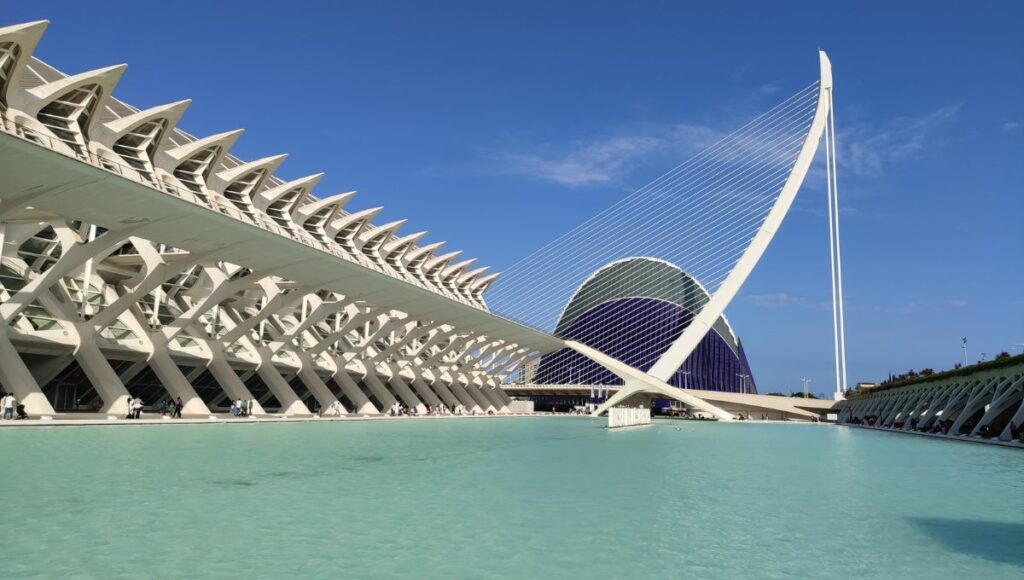
Provinces include: Alicante, Castellon, and Valencia.
The country’s national dish is Paella, and Valencia is known for having the best Paella in the world. Rightfully so. It is the birthplace of it. Located in the east of Spain, on the Mediterranean coast, in this region, you will find Costa Azahar and Costa Blanca. The capital and most populous city is Valencia. The region is bordered by Catalonia to the north, Aragon to the west, and Murcia to the south.
Valencia has a Mediterranean climate, with mild winters and hot summers. Valencia city is known for its rich history and culture, which can be seen in its many historic buildings and landmarks such as the Cathedral of Valencia, the City of Arts and Sciences complex, and the Central Market.
Cultural Highlights
- City of Arts and Sciences – An architectural marvel in Valencia, this complex captivates visitors with its futuristic buildings dedicated to science, art, and nature.
- Las Fallas – Valencia’s most explosive festival literally sets the city ablaze with fireworks, bonfires, and effigies, celebrating the renewal of spring.
- La Lonja de la Seda – A UNESCO World Heritage site, this Gothic masterpiece in the heart of Valencia was once a centre of silk trade and remains a symbol of the city’s mercantile history.
Iconic Dishes
- Paella Valenciana – The heart and soul of Valencian cuisine, this iconic dish features rice, chicken, rabbit, and green beans, cooked to perfection in a wide shallow pan.
- Horchata – This refreshing drink, made from tiger nuts, water, and sugar, is a beloved summer treat in Valencia.
- Fartons – Often enjoyed with horchata, these elongated, sweet pastries are perfect for dipping and savouring.
Famous People
- Joaquín Sorolla – Born in Valencia, Sorolla was a master painter, known for his brilliant use of light and colour, capturing the essence of Spanish life and landscapes.
- José Iturbi – A native of Valencia, Iturbi was a celebrated pianist and conductor, bringing Spanish music to the international stage.
- Santiago Calatrava – An architect from Valencia, Calatrava is renowned worldwide for his sculptural bridges and buildings, including the City of Arts and Sciences in Valencia.
The region is famous for its festivals, particularly the Fallas festival, which is held in March every year and celebrates the arrival of spring. Along Spain’s Mediterranean coast, in this region, you will find Costa Azahar and Costa Blanca. Both Valencia city and province and Alicante city and province are here waiting to be discovered.
Final thoughts
The exploration of Spain’s autonomous regions reveals the country’s depth and diversity. In the north, regions like Asturias and the Basque Country boast rugged coastlines and culinary innovations, while the central plateau showcases the historic grandeur of Castilla y León and the urban vibrancy of Madrid. The Mediterranean allure of Catalonia and Valencia beckons with their artistic legacies and gastronomic delights, as the islands of the Balearics and the Canaries offer paradisiacal escapes with their stunning landscapes and unique cultures.
Throughout this journey, we’ve delved into the heart of each region, uncovering the tales of famous figures, the flavours of iconic dishes, and the spirit of local festivals. From the architectural marvels of Valencia’s City of Arts and Sciences to the rustic charm of Andalucía’s white-washed villages, Spain unfolds as a country of contrasts and harmonies.
I’d love to hear from you! Share your favourite moment or region in Spain in the comments below. Whether it’s a hidden gem in the Pyrenees, a memorable meal in Madrid, or a sun-drenched afternoon on the Costa del Sol, let’s celebrate the rich tapestry of experiences that Spain offers.

